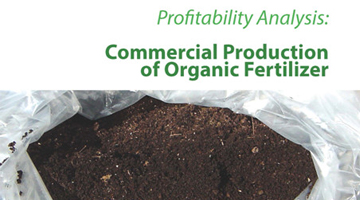 There are many reasons to commercially produce organic fertilizer. Organic fertilizer is good for the soil. It improves soil structure, maintains good crop growth, and protects the environment.
There are many reasons to commercially produce organic fertilizer. Organic fertilizer is good for the soil. It improves soil structure, maintains good crop growth, and protects the environment.
The demand for organic produce is also increasing due to consumers’ growing awareness on healthy foods. Organic farms producing food crops such as vegetables and rice require organic inputs such as organic fertilizer, to sustain their production year-round.
The high demand for organic fertilizer is also supported by the abundance of the needed raw materials such as animal manure, plant wastes, and market wastes which could have been a nuisance to the environment if not devoted to good use. Crop biomass such as rice hull; sugarcane bagasse; coconut shell, husks, and coir are also convertible to organic fertilizers.
Results of a PCAARRD-funded project indicate that an initial investment of P2.17 million can yield an average annual net profit of P619,000.00. Income can be realized on the first year of operation, based on the projected 10-year income statement and cash flow. Full recovery of the initial investment can be realized after 2 years and 7 months.
Moreover, financial indicators from the projected 10-year cash flow statement show that organic fertilizer production is a financially viable business. The estimated internal rate of return (IRR) is 31.64% while the net present value (NPV) is at P966,302.34 at a discount rate of 20%.
NPV in this project is the value of all cash to be received in a 10-year project life, net of expenses, and less initial investment to establish the production plant. A positive NPV indicates acceptability of the investment project. IRR, on the other hand, considers the time value of the money based on the cash flows over the project’s lifetime.
Details of these financial analyses can now be accessed through the recently-published booklet on “Profitability Analysis: Commercial Production of Organic Fertilizer.” The booklet also contains information on how to establish a production plant—the facility requirements; machinery and equipment; recommended raw materials and activator for composting; steps in composting; product registration; and marketing and distribution strategies.
This booklet is an output of the project “Investment Package for the Commercial Production of Organic Fertilizer,” implemented by the Central Luzon State University, coordinated by PCAARRD and funded through the Presidential Social Fund-Office of the Special Projects/Presidential Management Staff.
